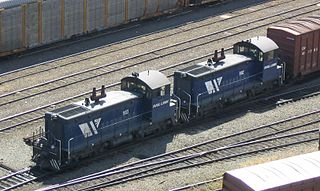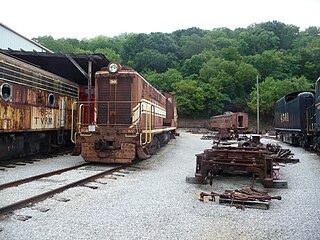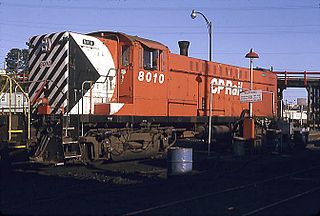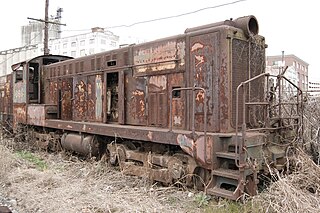
The Baldwin DR-12-8-1500/2 was the Baldwin Locomotive Works' first serious attempt at a production road diesel locomotive. The Baldwin type designation was 'DR-12-8-1500/2,' meaning Diesel Road locomotive, with 12 axles, and two engines of 1,500 horsepower (1,100 kW) each. The trucks were configured in a 2-D+D-2 wheel arrangement. The nickname came from the numerous axles set in a nearly unbroken line, much like the legs of a centipede.
The AAR wheel arrangement system is a method of classifying locomotive wheel arrangements that was developed by the Association of American Railroads. It is essentially a simplification of the European UIC classification, and it is widely used in North America to describe diesel and electric locomotives. It is not used for steam locomotives which use the Whyte notation instead.

An EMD SW900 is a diesel switcher locomotive built by General Motors Electro-Motive Division and General Motors Diesel (GMD) between December 1953 and March 1969. Power was provided by an EMD 567C 8-cylinder engine that generated 900 horsepower (670 kW). Built concurrently with SW1200, the eight-cylinder units had a single exhaust stack. The last two SW900s built by GMD for British Columbia Hydro were built with 8 cylinder 645E engines rated at 1,000 horsepower (750 kW).

The Baldwin S-12 was a 1,200-horsepower (890 kW) diesel-electric locomotive intended for use in yard switching. Utilizing a turbocharged 6-cylinder version of the powerful 606A diesel prime mover, S-12s were known for their "lugging" power, despite being temperamental. Like most Baldwin switchers, the S-12 had AAR Type-A switcher trucks in a B-B wheel arrangement. 451 units were built between 1951 and 1956, when Baldwin left the locomotive market.

The ALCO RS-2 is a 1,500–1,600 horsepower (1,100–1,200 kW) B-B road switcher diesel-electric locomotive built by the American Locomotive Company (ALCO) from 1946 to 1950. ALCO introduced the model after World War II as an improvement on the ALCO RS-1. The locomotive was one of several road switchers in a crowded market, including the Baldwin DRS-4-4-1500, EMD GP7, and FM H-15-44. ALCO discontinued the RS-2 in 1950 in favor of the ALCO RS-3. Several examples have been preserved.

The Baldwin AS-616 was a diesel-electric locomotive of the road switcher type rated at 1,600 horsepower (1,200 kW), that rode on three-axle trucks, having a C-C wheel arrangement. Nineteen railroads bought 214 locomotives, and two railroads bought seven cabless B units. The AS-616 was valued for its extremely high tractive effort, far more than any ALCo or EMD product. It was used in much the same manner as its four-axle counterpart, the Baldwin AS-16, and its six-axle sister, the Baldwin AS-416, though the six- traction motor design allowed better tractive effort at lower speeds.

The Baldwin DRS-6-6-1500 was a diesel-electric locomotive of the road switcher type rated at 1,500 horsepower (1,100 kW), that rode on a pair of three-axle trucks, having a C-C wheel arrangement.

The Baldwin VO-1000 was a diesel-electric locomotive (switcher) built by Baldwin Locomotive Works between January 1939 and December 1946. The 236,260–242,200 lb (107,170–109,860 kg) units were powered by a normally aspirated eight-cylinder diesel engine rated at 1,000 horsepower (746 kW), and rode on a pair of two-axle trucks in a B-B wheel arrangement. These were either the AAR Type-A switcher trucks, or the Batz truck originally developed by the Atchison, Topeka and Santa Fe Railway as a leading truck for steam locomotives. 548 examples of this model were built for American railroads, including examples for the Army and Navy.
The Baldwin VO-660 was a diesel-electric locomotive switcher built by Baldwin Locomotive Works between April, 1939 and May, 1946. The 197,520–203,980 lb units were powered by a six-cylinder diesel engine rated at 660 horsepower, and rode on two-axle AAR Type-A switcher trucks in a B-B wheel arrangement. 142 examples of this model were built for American railroads, along with the United States Navy. Baldwin replaced the VO-660 with the model DS-4-4-660 in 1946.
Baldwin Locomotive Works produced several different Baldwin DR-6 models of 6-axle passenger train-hauling diesel locomotives between 1945 and 1948. The series comprised eight individual versions, all of which sold only in small numbers; across all versions, only 39 locomotives were produced. Each version was produced only for a single railroad. Many shared the same Baldwin model number, DR-6-4-2000, even though they were rather different; this was because the Baldwin model only encoded the total axles (6), the driven axles (4) and the power output. The single exception was the single unit produced for the Chicago and North Western Railway, which had a single 1,000 hp (750 kW) engine and was model number DR-6-2-1000. In the AAR wheel arrangement scheme of classification, these locomotives were of A1A-A1A and A1A-3 arrangements, respectively.

The Baldwin DRS-4-4-1000 was a diesel-electric road switcher produced by the Baldwin Locomotive Works from July, 1948–March, 1950. The units featured a 1,000 horsepower (750 kW), six-cylinder prime mover, and were configured in a B-B wheel arrangement mounted atop a pair of two-axle AAR Type-B road trucks, with all axles powered. They had a cast steel frame. The units were configured to normally run with the long hood in the forward position.
The Baldwin DRS-4-4-1500 was a diesel-electric locomotive of the road switcher type rated at 1,500-horsepower (1,100 kW), that rode on two-axle trucks, having a B-B wheel arrangement. It was manufactured from 1947 until it was replaced in 1950 by the 1,600-horsepower (1,200 kW) AS-16.

The Baldwin DRS-6-4-1500 was a diesel-electric locomotive of the road switcher type rated at 1,500 horsepower (1,100 kW), that rode on three-axle trucks, having an A1A-A1A wheel arrangement. It was introduced in 1946, and was replaced in Baldwin's catalog by the AS-416 in 1950, but continued in production for export orders until 1952.
The Baldwin DS-4-4-750 was a four-axle 750 horsepower (560 kW) diesel-electric switcher built by the Baldwin Locomotive Works at it Eddystone, Pennsylvania factory between 1949 and 1951. It was a bridge between the 660 horsepower (490 kW) DS-4-4-660 and the S-8. It was the low power companion in Baldwin's catalog to their DS-4-4-1000 and the S-12.

The Baldwin DS-4-4-660 was a four-axle 660 horsepower (490 kW) diesel-electric switcher built by the Baldwin Locomotive Works at it Eddystone, Pennsylvania factory between 1946 and 1949. It replaced the 660 horsepower (490 kW) VO-660 in their catalog, and was in turn replaced by the 750 horsepower (560 kW) DS-4-4-750. It was the low power companion to Baldwin's DS-4-4-1000 models.

The Baldwin DS-4-4-1000 were two models of four-axle 1,000 horsepower (746 kW) diesel-electric switching locomotives built by the Baldwin Locomotive Works between 1946 and 1951. The first models was powered by an 8-cylinder normally aspirated prime mover, but from 1948, a change was made to the second model powered by a 6-cylinder turbocharged engine. These two models replaced the VO-1000 in Baldwin's catalogue, and were in turn replaced by the S-12 in 1951.
The Baldwin 4-8+8-4 750/8 DE1 was the Baldwin Locomotive Works' first attempt at road diesel locomotive. The trucks were configured in a 2-D+D-2 wheel arrangement. Only a single test unit was built.
The Baldwin DRS-6-4-750 is a Diesel-electric locomotive built by Baldwin Locomotive Works in 1949. The DRS-6-4-750 was powered by a naturally aspirated six-cylinder diesel engine rated at 750 horsepower (559 kW), and rode on a pair of three-axle trucks in an A1A-A1A wheel arrangement. One of these models were built for Office Chérifien des Phosphates (OCP) Railroad in Morocco.

The Baldwin DRS-6-4-660, known in France as the A1AA1A 62000, is a diesel-electric locomotive built by Baldwin Locomotive Works between 1946 and 1948. The DRS-6-4-660s were powered by a naturally aspirated six-cylinder diesel engine rated at 660 horsepower (492 kW), and rode on a pair of three-axle trucks in an A1A-A1A wheel arrangement. 106 of these models were built for railroads in Morocco and France.
The Baldwin 0-6-6-0 1000/1 DE is a cab unit diesel-electric locomotive built by Baldwin Locomotive Works in 1945. The 0-6-6-0 1000/1 DEs were powered by an eight-cylinder diesel engine rated at 1,000 horsepower (746 kW), and rode on a pair of three-axle trucks in a C-C wheel arrangement. 30 of these models were built for Soviet Railways, today Russian Railways, as Class Дб.














